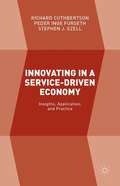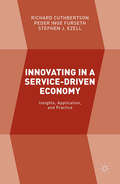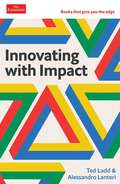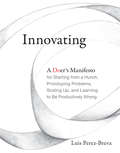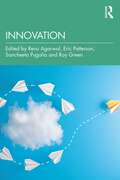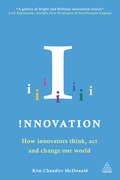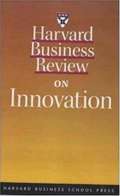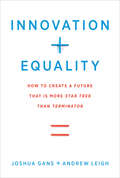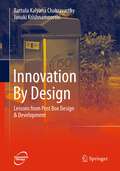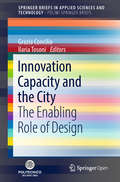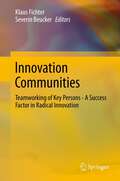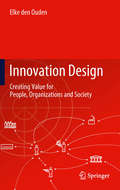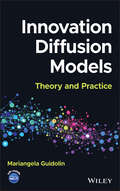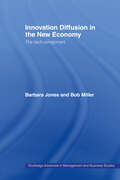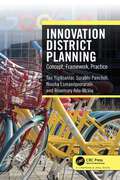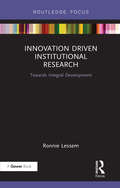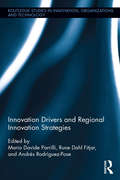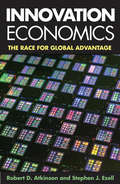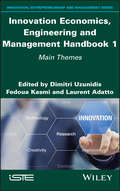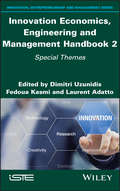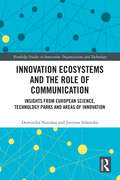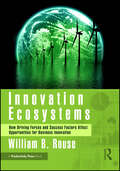- Table View
- List View
Innovating in a Service-Driven Economy: Insights, Application, and Practice
by Richard Cuthbertson Peder Inge Furseth Stephen J. EzellInnovating in a Service-Driven Economy.
Innovating in a Service-Driven Economy: Insights, Application, and Practice
by Richard Cuthbertson Stephen J. Ezell Peder Inge FursethThe global digital revolution has changed consumer society, service expectations, and funding models forever. Value Driven Service Innovation explores these changes from the perspectives of leading thinkers and practitioners in the field of innovation today.
Innovating with Impact: The Economist Edge Series (The Economist Edge Series)
by Alessandro Lanteri Ted LaddWe're all innovators now. Thinkers and entrepreneurs Ted Ladd and Alessandro Lanteri show us how to make the most of our ideas.It is a myth to consider innovation the domain of the special few who are inspired by "eureka!" moments that always result in brilliant new products. In reality, anyone with the right tools, traits, and methods has the potential to innovate with impact, generating profits and even changing the world. In this engaging guide, top thinkers and entrepreneurs Ted Ladd and Alessandro Lanteri show how to create innovations that deliver customer value. Their Innovation Pyramid outlines a strategic process that is rooted in the right cultures and mindsets and uses a range of methods, techniques and themes to reach the pinnacle of maximum impact. Throughout the book, stories and examples from different organisations and contexts bring the text to life. This book is essential reading for anyone who wants to create, innovate, improve performance, and ultimately, make a difference.
Innovating: A Doer's Manifesto for Starting from a Hunch, Prototyping Problems, Scaling Up, and Learning to Be Productively Wrong
by Luis Perez-BrevaDiscover the MIT-developed, &“doer&’s approach&” to innovation with this guide that reveals you don&’t need an earth-shattering idea to create a standout product, service, or business—just a hunch that you can scale up to impact. Innovation is the subject of countless books and courses, but there&’s very little out there about how you actually innovate. Innovation and entrepreneurship are not one and the same, although aspiring innovators often think of them that way. They are told to get an idea and a team and to build a show-and-tell for potential investors. In Innovating, Luis Perez-Breva describes another approach—a doer&’s approach developed over a decade at MIT and internationally in workshops, classes, and companies. He shows that innovating doesn&’t require an earth-shattering idea; all it takes is a hunch. Anyone can do it. By prototyping a problem and learning by being wrong, innovating can be scaled up to make an impact. As Perez-Breva demonstrates, &“nothing is new&” at the outset of what we only later celebrate as innovation. In Innovating, the process—illustrated by unique and dynamic artwork—is shown to be empirical, experimental, nonlinear, and incremental. You give your hunch the structure of a problem. Anything can be a part. Your innovating accrues other people&’s knowledge and skills. Perez-Breva describes how to create a kit for innovating, and outlines questions that will help you think in new ways. Finally, he shows how to systematize what you&’ve learned: to advocate, communicate, scale up, manage innovating continuously, and document—&“you need a notebook to converse with yourself,&” he advises. Everyone interested in innovating also needs to read this book.
Innovation
by Renu Agarwal Roy Green Eric Patterson Sancheeta PugaliaIn recent years, a great deal of attention has been focussed on the undertaking of managing innovation. Without the right focus, resourcing and capabilities, firms struggle to create value through innovation. However, the task of managing innovation is one of continuous paradoxes where an overly structured mind-set can impede entrepreneurship, creativity, culture and the right conditions for disruption. The question remains of how we can have the right lens to properly understand and appreciate innovation, and how we can have a flexible set of tools, techniques and perspectives to support innovation. This concise text introduces readers to one of the fundamental ideas in the business world. Insights into the key ingredients of innovation, including business models, services, entrepreneurship and creativity are analysed alongside core contexts, such as disruptive technology. Students of business and management will appreciate additional coverage of the future of the field, including open innovation and the dark side of digital disruption. This accessible book provides a thought-provoking, stimulating perspective that will make it a valuable resource for a range of academic and student audiences across business and management disciplines.
Innovation
by Kim Chandler McdonaldAny organisation looking to succeed in the global digital economy of today - and tomorrow - must innovate. !nnovation introduces the global pioneers whose ideas and products have driven the changes that have revolutionised our world in every field. It showcases the pioneers who have broken the mould and led the pack in every field from business and technology to food, fashion, culture and healthcare. Drawing on exclusive interviews with more than 100 leading innovators from around the world, !nnovation highlights the common denominators linking these highly creative people. It presents the inside track on who's done what, how they did it, what drives them on, and why innovation is so critical to individuals, businesses and to society as a whole. This book is a fascinating, fast-paced read and more importantly, it will empower you and your business to be more innovative too.
Innovation + Equality: How to Create a Future That Is More Star Trek Than Terminator (The\mit Press Ser.)
by Joshua Gans Andrew LeighHow to get more innovation and more equality.Is economic inequality the price we pay for innovation? The amazing technological advances of the last two decades—in such areas as artificial intelligence, genetics, and materials—have benefited society collectively and rewarded innovators handsomely: we get cool smartphones and technology moguls become billionaires. This contributes to a growing wealth gap; in the United States; the wealth controlled by the top 0.1 percent of households equals that of the bottom ninety percent. Is this the inevitable cost of an innovation-driven economy? Economist Joshua Gans and policy maker Andrew Leigh make the case that pursuing innovation does not mean giving up on equality—precisely the opposite. In this book, they outline ways that society can become both more entrepreneurial and more egalitarian. All innovation entails uncertainty; there's no way to predict which new technologies will catch on. Therefore, Gans and Leigh argue, rather than betting on the future of particular professions, we should consider policies that embrace uncertainty and protect people from unfavorable outcomes. To this end, they suggest policies that promote both innovation and equality. If we encourage innovation in the right way, our future can look more like the cheerful techno-utopia of Star Trek than the dark techno-dystopia of The Terminator.
Innovation Beyond Technology: Science for Society and Interdisciplinary Approaches (Creative Economy)
by Sébastien LechevalierThe major purpose of this book is to clarify the importance of non-technological factors in innovation to cope with contemporary complex societal issues while critically reconsidering the relations between science, technology, innovation (STI), and society. For a few decades now, innovation—mainly derived from technological advancement—has been considered a driving force of economic and societal development and prosperity. With that in mind, the following questions are dealt with in this book: What are the non-technological sources of innovation? What can the progress of STI bring to humankind? What roles will society be expected to play in the new model of innovation? The authors argue that the majority of so-called technological innovations are actually socio-technical innovations, requiring huge resources for financing activities, adapting regulations, designing adequate policy frames, and shaping new uses and new users while having the appropriate interaction with society. This book gathers multi- and trans-disciplinary approaches in innovation that go beyond technology and take into account the inter-relations with social and human phenomena. Illustrated by carefully chosen examples and based on broad and well-informed analyses, it is highly recommended to readers who seek an in-depth and up-to-date integrated overview of innovation in its non-technological dimensions.
Innovation By Design
by Chakravarthy B K Janaki KrishnamoorthiThe book provides an in-depth knowledge on how a product is designed and developed by Product Designers. This has been achieved through a case study of one product - the Post Box. This product was chosen for the study primarily due to its simple and non-technical nature as that would make it easy for the readers to comprehend the design process. At the same time the Post Box posed all the challenges a designer would face while creating a new product. Through a step by step process the book gradually takes the reader through the design and development journey - right from understanding the product, identifying the user need through market research, comprehending client's brief, generating product ideas and concepts to development of prototype, manufacturing and final performance of the product. Interestingly, the book also includes how the product had to be modified after its initial launch as a large section of the public failed to identify it as a Post Box! To make the book more stimulating, innovative case studies with interesting facts, figures and pictures on related issues like origin and evolution of Post Boxes in India and abroad are included. They are presented separately in boxes and columns without interrupting the flow of the core subject matter. The narrative and the language is simple and lucid and possibly balanced with a vivid formatting and layout that is easy on the eye.
Innovation Capacity and the City: The Enabling Role of Design (SpringerBriefs in Applied Sciences and Technology)
by Grazia Concilio Ilaria TosoniThis open access book represents one of the key milestones of DESIGNSCAPES, an H2020 CSA (Coordination and Support Action) research project funded by the European Commission under the Call “User-driven innovation: value creation through design-enabled innovation”. The book demonstrates that adopting design allows us to embed innovation within the city so as to arrive at feasible answers to complex global challenges. In this way, innovation can become disruptive, while also sparking a dynamic of gradual change in the “urbanscape” it acts within. To explore this potential, the book puts forward the concept of “design enabled innovation in urban environments” and examines the part that the city can play in promoting and facilitating the adoption of design among public and private sector innovators. This leads to a potential evaluation framework in which a given urbanscape is assessed both in terms of its capacity for generating innovation, and of the nature (more or less design-dependent or design-prone) of the innovative initiatives it hosts. This thread of reasoning holds many promising implications, including a possible “third way” between those who dream of an alternative economic model where revenues and growth are sacrificed on the altar of social and environmental respect, and the supporters of the traditional market-based view, who feel it is enough to add a touch of responsibility and concern to a system that should continue rewarding the profitability of innovations.
Innovation Communities: Teamworking of Key Persons - A Success Factor in Radical Innovation
by Klaus Fichter Severin BeuckerSelf-organising networks have become the dominant innovators of complex technologies and radical innovation. The growing need for co-operation to ensure innovation success calls for a broader understanding of what makes innovation projects successful and requires new concepts. The book introduces the new concept of "innovation communities", defining them as informal networks of like-minded individuals who act as innovation promotors or champions. These key figures come from various companies and organisations and will team up in a project-related fashion, jointly promoting a certain innovation, product or idea either on one or across different levels of an innovation system. The publication presents findings from surveys that demonstrate that networks of champions are a success factor in radical innovation. Five case studies of noteworthy innovation projects illustrate why the collaboration of champions can make innovation projects more successful. Furthermore, the book presents hands-on methods and includes best-practice cases and guidelines on how to develop innovation communities. This publication comprises empirical findings and practical experiences that are valuable for the following groups in particular: Entrepreneurs; Innovation, R&D, and network managers; Innovation and strategy consultants; Innovation and start-up intermediaries; Innovation researchers; Government officials and politicians responsible for R&D and innovation programmes and funding
Innovation Corrupted: The Rise and Fall of Enron (A)
by Malcolm S. SalterPresents a brief historical overview of Enron's rise, its strategic successes and failures, the evolution of its business model, and the organizational processes relied upon by Enron's management to drive and monitor the business. A rewritten version of an earlier case.
Innovation Design
by Elke Den OudenInnovation Design presents an approach to designing shared value for businesses, non-profit organizations, end-users and society. The societal and economic challenges we are currently facing - such as the aging population, energy scarcity and environmental issues - are not just threats but are also great opportunities for organizations. Innovation Design shows how organizations can contribute to the process of generating value for society by finding true solutions to these challenges. And at the same time it describes how they can capture value for themselves in business ecosystems that care for both people and planet. This book covers: creating meaningful innovations that improve quality of life, engage users and provide value for organizations and other stakeholders, guiding the creation of shared value throughout the innovation process, with a practical and integrative approach towards value that connects ideas from economics, psychology, sociology and ecology, designing new business models and business ecosystems to deliver sustainable benefits for all the involved parties and stakeholders, addressing both tangible and intangible value. Innovation Design gives numerous examples of projects and innovations to illustrate some of the challenges and solutions you may encounter in your journey of designing meaningful innovations and creating shared value. It also offers practical methods and tools that can be applied directly in your own projects. And in a fast-changing world, it provides a context, a framework and the inspiration to create value at every level: for people, for organizations and for the society in which we live.
Innovation Diffusion Models: Theory and Practice
by Mariangela GuidolinInnovation Diffusion Models Understand innovation diffusion models and their role in business success Innovation diffusion models are statistical models that predict the medium- and long-term sales performance of new products on a market. They account for numerous factors that contribute to the life cycle of a new product and are subject to continuous reassessment as markets transform and the business world becomes more complex. In a modern market environment where product life cycles are becoming ever shorter, the latest innovation diffusion models are essential for businesses looking to perfect their decision-making processes. Innovation Diffusion Models: Theory and Practice provides a comprehensive and up-to-date guide to these models and their potential to impact product development. It focuses on the latest product diffusion models, which combine time series analysis with nonlinear regression techniques to create increasingly refined predictions. Its combination of mathematical theory and business practice makes it an indispensable tool across many sectors of industry and commerce. Innovation Diffusion Models readers will also find: Real-world examples demonstrating the kinds of data sets generated by new product growth models and their potential applications Discussion of the factors underlying the decision to select a given growth model for a particular product Clear, detailed explanation of each model’s explanatory ability Innovation Diffusion Models is an essential volume for practitioners in any field of industry or commerce, as well as for graduate students and researchers in business and finance.
Innovation Diffusion in the New Economy: The Tacit Component (Routledge Advances In Management And Business Studies)
by Barbara Jones Bob MillerThis book unites discussions of the philosophical and scientific basis of tacit knowledge.The authors give an overview of the theories of tacit knowledge and explain how these relate to a background of philosophical, neurological and pedagogic literature. The importance of tacit knowledge for evolutionary models of innovation is analyzed raising qu
Innovation District Planning: Concept, Framework, Practice
by Tan Yigitcanlar Surabhi Pancholi Niusha Esmaeilpoorarabi Rosemary Adu-McVieThis book aims to fill the knowledge gap on how to plan, develop and manage innovation districts that are competitive in terms of both productivity and quality of living, justifying the massive investment put into place and at the same time doing both in a delicate and harmonious way.There is a need for smart urban land use that is wired with both hard infrastructures (e.g., telecommunication and transport) and soft infrastructures (e.g., diversity and tolerance). The reader learns this knowledge through conceptual expansions for key insights, frameworks for potential and performance assessment and best practices for global innovation districts. The authors begin innovation district planning with the role and effectiveness of planning a branding in the development of innovation districts. The next key topic of place making is recognised as a key strategy for supporting knowledge generation and innovation activities in the contemporary innovation districts. Another important topic is place quality where the reader learns to identify and classify indicators of place quality by studying global innovation districts best practices. The reader also expands their understanding on the classification of innovation districts based on their key characteristics through a methodological approach. The book concludes with district smartness studied through the socio-cultural role played by anchor universities in facilitating place making in innovation districts. Smart campuses, enabled by digital transformation opportunities in higher education, are seen as a miniature replica of smart cities and serve as living labs for smart technology.The book serves as a repository for scholars, researchers, postgraduate and undergraduate students as it communicates the complex innovation district phenomenon in an easy-to-digest form by providing both the big picture view and specifics of each component of that view.
Innovation Driven Institutional Research: Towards Integral Development (Transformation and Innovation)
by Ronnie LessemThis is the third volume in the CARE-ing for Integral Development series. It continues to build on the previous two works, Community Activation and Awakening Integral Consciousness, as well as preceding the fourth and final book, Embodying Integral Development. This book serves as a follow-up to the author's approach to integral research and development, economics and enterprise, contained within the Innovation and Transformation series, and as a focus for how put all of this "CARE-fully" to work. This third volume, in the CAREquartet is perhaps the most crucial one, building on the organizational systems (see Awakening Integral Consciousness) that came before and turning from trans-cultural and transformational to trans-disciplinary, from integral reality and integral rhythm to integral realms, with a view ultimately to transpersonal, integral rounds. The author turns his attention to research and innovation, and then focuses in on enterprise and economics, management and leadership. As such, he introduces his Inter-Institutional Genealogyin place of an "integral", yet still inhibiting, university. In the process this book paves the way for a new kind of institutionalized, innovation driven social research, which, while rooted in a particular place, speaks to the world as a whole. Moreover, such a research-and-innovation institution has a fundamental role to play in the evolution of a specific community, building on what has come CARE-wise before.
Innovation Drivers and Regional Innovation Strategies (Routledge Studies in Innovation, Organizations and Technology)
by Andrés Rodriguez-Pose M. Davide Parrilli Rune Dahl FitjarIn the global economy, regional development and innovation are increasingly an imperative to increase the competitive edge of EU economies. While European regions are different in many ways, the innovation capacity of regions, clusters and firms is what makes them capable of building up new and diversified pathways for sustainable growth. For this reason, Innovation Drivers and Regional Innovation Strategies looks to analyze different knowledge drivers (e.g. entrepreneurial or policy-orientation; scientific and practice-based knowledge modes; institutional innovation support) that influence the innovative and competitive capacity of regions, clusters and firms in Europe. The aim of this volume is to develop an in-depth understanding of these drivers and their implications for the way in which regional and cluster growth may be upgraded. Innovation Drivers and Regional Innovation Strategies examines the construction of new innovation pathways for regions and clusters in different geographical contexts. The main themes are cluster evolution, regional innovation systems and business innovation modes and capabilities. The objectives are centred on exploring the logic and mechanisms that can be activated as a means to promote innovation and competitiveness within regions and, within these, across and within firms. Aimed at researchers and academics in the field, this is a thoughtful and innovative new volume that helps define the academic debate.
Innovation Economics
by Robert D. AtkinsonThis important book delivers a critical wake-up call: a fierce global race for innovation advantage is under way, and while other nations are making support for technology and innovation a central tenet of their economic strategies and policies, America lacks a robust innovation policy. What does this portend? Robert Atkinson and Stephen Ezell, widely respected economic thinkers, report on profound new forces that are shaping the global economy—forces that favor nations with innovation-based economies and innovation policies. Unless the United States enacts public policies to reflect this reality, Americans face the relatively lower standards of living associated with a noncompetitive national economy. The authors explore how a weak innovation economy not only contributed to the Great Recession but is delaying America's recovery from it and how innovation in the United States compares with that in other developed and developing nations. Atkinson and Ezell then lay out a detailed, pragmatic road map for America to regain its global innovation advantage by 2020, as well as maximize the global supply of innovation and promote sustainable globalization.
Innovation Economics, Engineering and Management Handbook 1: Main Themes
by Dimitri Uzunidis Fedoua Kasmi Laurent AdattoInnovation, in economic activity, in managerial concepts and in engineering design, results from creative activities, entrepreneurial strategies and the business climate. Innovation leads to technological, organizational and commercial changes, due to the relationships between enterprises, public institutions and civil society organizations. These innovation networks create new knowledge and contribute to the dissemination of new socio-economic and technological models, through new production and marketing methods. Innovation Economics, Engineering and Management Handbook 1 is the first of the two volumes that comprise this book. The main objectives across both volumes are to study the innovation processes in today's information and knowledge society; to analyze how links between research and business have intensified; and to discuss the methods by which innovation emerges and is managed by firms, not only from a local perspective but also a global one. The studies presented in these two volumes contribute toward an understanding of the systemic nature of innovations and enable reflection on their potential applications, in order to think about the meaning of growth and prosperity.
Innovation Economics, Engineering and Management Handbook 2: Special Themes
by Dimitri Uzunidis Fedoua Kasmi Laurent AdattoInnovation, in economic activity, in managerial concepts and in engineering design, results from creative activities, entrepreneurial strategies and the business climate. Innovation leads to technological, organizational and commercial changes, due to the relationships between enterprises, public institutions and civil society organizations. These innovation networks create new knowledge and contribute to the dissemination of new socio-economic and technological models, through new production and marketing methods. Innovation Economics, Engineering and Management Handbook 2 is the second of the two volumes that comprise this book. The main objectives across both volumes are to study the innovation processes in today's information and knowledge society; to analyze how links between research and business have intensified; and to discuss the methods by which innovation emerges and is managed by firms, not only from a local perspective but also a global one. The studies presented in these two volumes contribute toward an understanding of the systemic nature of innovations and enable reflection on their potential applications, in order to think about the meaning of growth and prosperity
Innovation Ecosystems (Wiley-iste Ser.)
by Eunika Mercier-LaurentWith innovation fast becoming omnipresent and part of strategic matters, there is a growing need to understand how to jumpstart the innovation process. This book introduces the concept of "e-co-innovation," which fosters the successful transition from idea to reality and ultimate value. It provides a global and system overview of the subject and presents various aspects of innovation from different angles and perspectives, leading to an understanding of all ecosystem components, their metamorphoses, cross-influences and possible impacts on the balanced development of people, businesses, regions and countries.
Innovation Ecosystems and the Role of Communication: Insights from European Science, Technology Parks and Areas of Innovation (Routledge Studies in Innovation, Organizations and Technology)
by Dominika Narożna Justyna AdamskaThis book analyses the role of communication in creating the value of innovation ecosystems from the perspective of the international network of technology parks and areas of innovation. It explores the relations and interactions between different stakeholders (administration, universities, business, innovation agencies), highlighting the important role of communication within successful innovation ecosystems.The role of communication is explained using different levels of communication approach. The authors present communication as a complex process, involving all the ecosystem stakeholders who are as well motivated and involved in different roles, norms, business models, environments, organizations, cultures, etc. The book proposes novel and interdisciplinary research (management, social communication and journalism, political science and administration) focused on the potential of communication in order to design the paradigm and indicate practical implications. The authors take into consideration modern IT tools, which provide the ground for redefining the connections between stakeholders, as well as sustainable development and ESG values, which change the perspective and priorities of the ecosystem.Innovation Ecosystems and the Role of Communication is written for scholars and researchers in the fields of innovation studies, management science, and communication studies.
Innovation Ecosystems: How Driving Forces and Success Factors Affect Opportunities for Business Innovation
by William B RouseThis book is about geography, economics, society, and innovation. Why did different regions evolve in different ways? What caused economic priorities and activities to go in one direction or another? The author believes that happenstance played a relatively minor role in this process. There were and are driving forces, as well as success factors.In each ecosystem, ambitious immigrants arrived, displaced native populations, and proceeded to develop and exploit the geography of their ecosystem, which included leveraging water resources for transportation, commerce, irrigation, etc. They often invented the means of development and exploitation, unfortunately including slavery, but also various technical methods, tools, and devices. Inventions that became innovations enabled industries, revenues, profits, and economic growth, initially for the ecosystem and then more broadly.The impacts of geography and economics are profound. Available resources strongly affect the options available for sustainable economic growth. This growth is fueled by technological innovations that are significantly affected by the physical, economic, and social characteristics of the ecosystem of interest.The eight case studies in this book illustrate how patterns of these characteristics impact innovation. They also depict changes over centuries, rather than just decades or years. Today’s crises are often just blips in the ongoing evolution of an innovation ecosystem. There are ups and downs, but the physical, economic, and social characteristics of the ecosystems dominate their evolution. These factors largely determine what potential innovations are pursued, who leads these pursuits, and why they think they can succeed. People and organizations dominate the factors influencing success.
